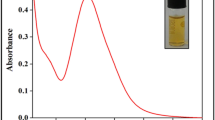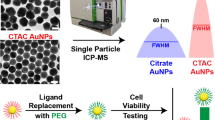Abstract
Colloidal nanoparticles (NPs) interact with biological fluids such as human plasma to form a protein coating (corona) on the surface of NPs (NP-protein complex). However, the impact of size and type of NPs on binding of the hard corona to the surface of NPs as well as damping of their optical spectra has not been systematically explored. To elucidate the interaction between biological environment (human plasma) and NPs, a photophysical measurement was conducted to quantify the interaction of two different types of NPs (gold (Au) and silver (Ag)) with common human plasma proteins. The colloidal AuNPs and AgNPs were electrostatically stabilized and varied in diameter from 10 to 80 nm in the presence of common human plasma. The sizes of the NPs were determined using transmission electron microscopy (TEM). Optical absorption spectra were obtained for the complexes. Dynamic light scattering (DLS) measurement and zeta potential were used to characterize the sizes, hydrodynamic diameters, and surface charges of the protein-NPs complexes. Protein separation was performed using sodium dodecyl sulfate-polyacrylamide gel electrophoresis (SDS-PAGE) to isolate and identify the protein bands. The absorption of proteins to the NPs was found to be strongly dependent on the size and type of NPs. The distance between surface of NPs by absorbed protein bound to the NPs gradually increased with size of NPs, particularly for AgNPs with primary diameter of < 50 nm. The chi-square test proved that AgNPs are a good candidate in sensing the protein complex in human plasma compared with AuNPs mainly for the AgNPs with diameter sized 50 nm.










Similar content being viewed by others
References
Deng ZJ, Mortimer G, Schiller T, Musumeci A, Martin D, Minchin RF (2009) Differential plasma protein binding to metal oxide nanoparticles. Nanotechnology 20(45):455101
Benetti F, Fedel M, Minati L, Speranza G, Migliaresi C (2013) Gold nanoparticles: role of size and surface chemistry on blood protein adsorption. J Nanopart Res 15(6):1694
Zhang Y, Qi S, Liu Z, Shi Y, Yue W, Yi C (2016) Rapid determination of dopamine in human plasma using a gold nanoparticle-based dual-mode sensing system. Mater Sci Eng C 61:207–213
Lacerda SHDP, Park JJ, Meuse C, Pristinski D, Becker ML, Karim A, Douglas JF (2009) Interaction of gold nanoparticles with common human blood proteins. ACS Nano 4(1):365–379
Sen T, Mandal S, Haldar S, Chattopadhyay K, Patra A (2011) Interaction of gold nanoparticle with human serum albumin (HSA) protein using surface energy transfer. J Phys Chem C 115(49):24037–24044
Austin LA, Mackey MA, Dreaden EC, El-Sayed MA (2014) The optical, photothermal, and facile surface chemical properties of gold and silver nanoparticles in biodiagnostics, therapy, and drug delivery. Arch Toxicol 88(7):1391–1417
Selva Sharma A, Ilanchelian M (2015) Comprehensive multispectroscopic analysis on the interaction and corona formation of human serum albumin with gold/silver alloy nanoparticles. J Phys Chem B 119(30):9461–9476
Corbo C, Molinaro R, Parodi A, Toledano Furman NE, Salvatore F, Tasciotti E (2016) The impact of nanoparticle protein corona on cytotoxicity, immunotoxicity and target drug delivery. Nanomedicine 11(1):81–100
Kubo S, Diaz A, Tang Y, Mayer TS, Khoo IC, Mallouk TE (2007) Tunability of the refractive index of gold nanoparticle dispersions. Nano Lett 7(11):3418–3423
Foerster B, Joplin A, Kaefer K, Celiksoy S, Link S, Sönnichsen C (2017) Chemical interface damping depends on electrons reaching the surface. ACS Nano 11(3):2886–2893
Mehrdel B, Aziz AA, Yoon T, Lee S (2017) Effect of chemical interface damping and aggregation size of bare gold nanoparticles in NaCl on the plasmon resonance damping. Optical Materials Express 7(3):955–966
Treuel L, Nienhaus GU (2013) Nanoparticle interaction with plasma proteins as it relates to biodistribution. In: Handbook of immunological properties of engineered nanomaterials. World Scientific, Singapore, pp 151–172
Aggarwal P, Hall JB, McLeland CB, Dobrovolskaia MA, McNeil SE (2009) Nanoparticle interaction with plasma proteins as it relates to particle biodistribution, biocompatibility and therapeutic efficacy. Adv Drug Del Rev 61(6):428–437
Quinten M (2011) Optical properties of nanoparticle systems: Mie and beyond. Wiley-VCH, Weinheim
Badawy AME, Luxton TP, Silva RG, Scheckel KG, Suidan MT, Tolaymat TM (2010) Impact of environmental conditions (pH, ionic strength, and electrolyte type) on the surface charge and aggregation of silver nanoparticles suspensions. Environ Sci Technol 44(4):1260–1266
Jain PK, Huang W, El-Sayed MA (2007) On the universal scaling behavior of the distance decay of plasmon coupling in metal nanoparticle pairs: a plasmon ruler equation. Nano Lett 7(7):2080–2088
Liebsch A (2013) Electronic excitations at metal surfaces. Springer Science & Business Media, Berlin
Walkey CD, Chan WC (2012) Understanding and controlling the interaction of nanomaterials with proteins in a physiological environment. Chem Soc Rev 41(7):2780–2799
Capjak I, Goreta SŠ, Jurašin DD, Vrček IV (2017) How protein coronas determine the fate of engineered nanoparticles in biological environment. Arch Ind Hyg Toxicol 68(4):245–253
Mehrdel B, Aziz AA (2018) Dependency of plasmon resonance sensitivity of colloidal gold nanoparticles on the identity of surrounding ionic media. Mater Res Express 5(3):035011
Mehrdel B, Aziz AA (2018) The sensitivity of surface plasmon resonance damping for colloidal silver nanoparticles. In: Journal of Physics: Conference Series, vol 1. IOP Publishing, p 012042
Funding
The authors would like to thank Universiti Sains Malaysia for funding this research work through its Transdisciplinary Research Grant Scheme (203.PFIZIK.6763003).
Author information
Authors and Affiliations
Corresponding authors
Additional information
Publisher’s Note
Springer Nature remains neutral with regard to jurisdictional claims in published maps and institutional affiliations.
Rights and permissions
About this article
Cite this article
Mehrdel, B., Othman, N., Aziz, A.A. et al. Identifying Metal Nanoparticle Size Effect on Sensing Common Human Plasma Protein by Counting the Sensitivity of Optical Absorption Spectra Damping. Plasmonics 15, 123–133 (2020). https://doi.org/10.1007/s11468-019-01007-7
Received:
Accepted:
Published:
Issue Date:
DOI: https://doi.org/10.1007/s11468-019-01007-7




